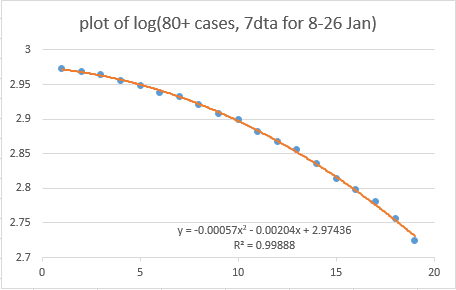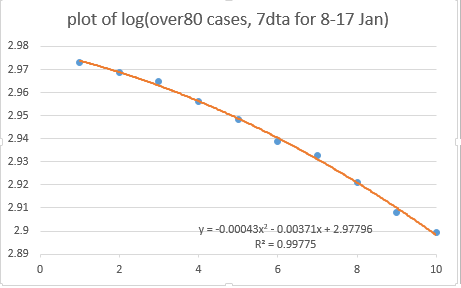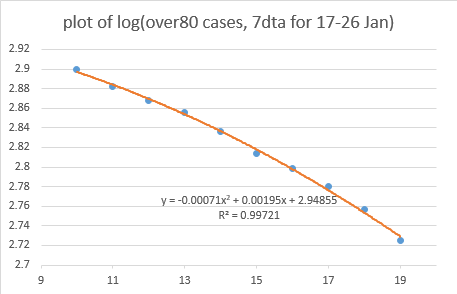I have updated my analysis of potential vaccine effects in over-80s cases with today’s latest dashboard data. I am increasingly confident that this does show an actual impact of vaccines, for the following reasons: (THREAD) https://twitter.com/JamesWard73/status/1354787659441385473?s=20
1) The trend is continuing to follow a clear quadratic curve, as per @BristOliver's prediction
2) The implied rate of rate of protection from that curve matches almost exactly with the NHS vaccination data, if you assume a 2-week lag to protection, and a 50% rate of protection from the first dose: both come to ~0.6% of the over-80s age group getting protection per day
The first-dose protection would be higher if you assume a 3-week lag (as there were slightly fewer vaccinations in the earlier weeks). this may be closer to reality as per latest Israeli data showing (I think) a 18-19 day lag in this age group - then protection works out to ~70%
3) Splitting the period we have into two, the implied rate of protection in the second half (17-26 Jan) is slightly stronger than in the first half (8-17 Jan) – which fits with a slightly faster rate of vaccination in early Jan than in late Dec
4) I haven’t heard any other plausible reason to create such a quadratic trend in the over-80s (and not other age groups); for example the rate of natural infection in this age group is way too low to create this pattern
5) Although there is a similar steepening in the overall case data –as per @bristoliver’s daily plot based on report-date cases, or @ThatRyanChap’s similar plot of specimen-date cases- if you look back a bit in the history, this is clearly a different shape: cubic, not quadratic
And the cubic shape is only happening in some age groups: most strongly in primary-age kids and (more weakly) their parents’ generation, and hardly at all in the 15-30 year-olds or in the 60-80s.
I think we have some plausible reasons why this might be happening – e.g. see my thread below. Some have challenged that a 1-day effect doesn’t intuitively seem big enough to cause this effect, but I think they might be wrong – I’ll post more on this later https://twitter.com/JamesWard73/status/1355301881564815360?s=20
In any event, you don’t have to believe that 1-day mixing effect is what’s causing the cubic shape in primary-age children and their parents, you just have to think it’s a different effect to what’s going on in the over-80s. and I’m pretty sure it is.
6) (although this isn't really a reason, more an observation) I have also looked at the regional and age-splits within the over-80s, to see if there might be some interesting patterns there.
the regional data is quite noisy, and some regions had later peaks than others (due to Tiers being different etc) which makes things tricky. and the regional rates of vaccination are not sufficiently different to be able to pick them up reliably in the data at this stage.
On the age splits, again it’s a bit noisy, particular as the over-90s had a late peak in cases so it’s hard to separate the vaccine effect from the curvature of the peak. But there are some patterns in the data which could indicate a shift in focus...
...from vaccinating the over-90s towards the 85-89s and then the 80-85s in early January. I’m cautious about this (and hence not posting graphs) as I think there’s a real risk of over-interpretation / confirmation bias. Time will tell.
But taking a step back, and looking at the over-80s group as a whole, I think it’s now staring us in the face: the quadratic trend on the log plot that @BristOliver predicted is clearly present, and is showing the positive effect of vaccines. /end

 Read on Twitter
Read on Twitter




